Welcome to Card Game DB
Register now to gain access to all of our features. Once registered and logged in, you will be able to create topics, post replies to existing threads, give reputation to your fellow members, get your own private messenger, post status updates, manage your profile and so much more. If you already have an account, login here - otherwise create an account for free today!
Register now to gain access to all of our features. Once registered and logged in, you will be able to create topics, post replies to existing threads, give reputation to your fellow members, get your own private messenger, post status updates, manage your profile and so much more. If you already have an account, login here - otherwise create an account for free today!
[Casterly Rock] Up the River!
Jun 30 2014 04:20 AM |
Aioria
in Game of Thrones
Game of Thrones Casterly Rock Aioria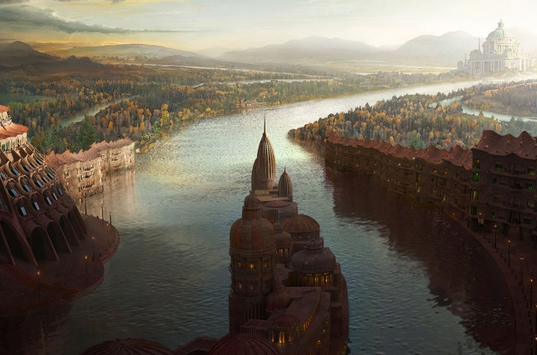 The plots with the River trait represent a design concept that tried to give a new and bigger depth to the variety of plots in AGoT. The original idea was to play plot cards that were related with each other bidirectionally, being then important not only what plot you will play next, but the plot that you have played before.
The plots with the River trait represent a design concept that tried to give a new and bigger depth to the variety of plots in AGoT. The original idea was to play plot cards that were related with each other bidirectionally, being then important not only what plot you will play next, but the plot that you have played before.The River plots do not stack up, as the Cities do; instead, to their when revealed effects they sum the one of the plot that was played right before, that will be then duplicated. The objective with this design was to represent the course of a river, following the plot that takes Tyrion along the Rhoyne in Dance with Dragons, the biggest river in Essos. Descending ther river until its end in Volantis, that isn’t free of dangers and adventures, and that the river plots tried to capture.
Nevertheless, this design concept has been continued by Fantasy Flight Games along several cycles, looking for new waters beyond Mother Rhoyne; rivers in Westeros, that have been represented through different plots.
And like the big rivers, the history of those plots has been growing, receiving the strength of their affluents and expansions until overflowing their riverbed and becoming the group of plots by excellence of the competitive game since the release of their last and more important card: Crossing the Mummer’s Ford, in early 2014.
In this article we’re going to navigate along the current of the River plots, from their birth to their end, with their growth and droughts, until the formation of a very compact and efficient combination.
The river plots appear for the first time in AGoT in the cycle of Beyond the Narrow Sea in 2012, representing Tyrion’s voyage, with Griff, Duck, Haldon, the young “Griff†and co. along the Rhoyne in their way to Volantis, the big city that crowns its river mouth. Despite the novelty of its design, the ability to replicate the immediate previous effects instead of simply stacking plots with a common trait – and how refreshing this was for the game in that moment- the River plots passed by with no pain nor glory in their origins before the sight of the competitive player. The main reason for this was their disastrous numbers: an average income of 2,5 Golden Dragons and quite low iniciatives. Their effects, while being interesting, didn’t seem to justify in any case such a poor gold curve. So, apart from some exceptions, they remained forgotten for months.
Let’s remember really quick the effects of each of these seven plots that were released in BtNS:
- To reveal and add a card to the hand, copying the previous river
- To choose each player a card in their control and return it to the top of their decks, copying the previous river.
- To discard the first card of the opponents deck, copying the previous river. Also, claim 2.
- Each opponent chooses and discards a card from their hand, copying the previous river. And with 1 gold income
- To name a challenge, and to attack and defend all players must declare for that challenge all eligible characters, copying the effects of the previous river.
- Each player returns the first character of their dead pile to the top of their deck, copying the previous river.
- To add 2 gold and copy any river in your used plots deck, not necessarily the immediate previous one.
As we can see, they’re curious effects, but also irrelevant in the majority of the cases except if we have very powerful entrance effects (At the Palace of Sorrows would be interesting then). Not even the three additional cards that we could obtain playing rivers justified playing this plots.
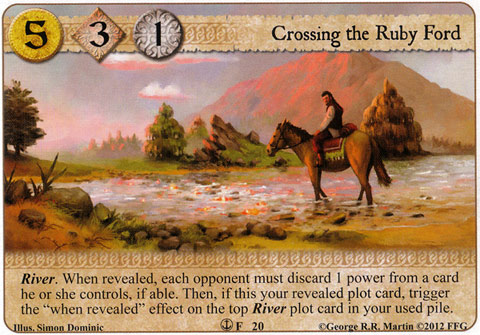
Crossing the Ruby Ford managed to make more visible the river plots in some decks, but they still seemed circumscribed to the decks with KotHH agenda (Knights of the Hollow Hill) to compensate their low income. The usual thing was to play 3 or 4 of these plots maximum, trying to activate the deck through the draw that they could provide.
Time passed, and the next cycle arrived -The Kingsroad- bringing new river plots, this time related with one of the cycle’s turning point: the cards “under commandâ€. We have in the first place Befouled River that with its 2 of income, provided with an attack for the player with more cards under command. On other hand, Redwyn Straitsgave 4 golden dragons for the player with less command. A common point of both plots is that they didn’t copy previous river plots, breaking then the dynamics of these plots.
Given its effect, that depended on having less command, and with the risk that they turned against us in certain cases, made that these plots remained related almost exclusively to KotHH again. A lot of decks used this plots for a while, especially Redwyn Straits. But with the 5.0 FAQs and their errata to the KotHH to avoid abuses related to the command concept ended with the competitive adventure of these two plots, that are from that moment in the folders in the majority of the cases. Maybe in a not very far future, with the new “Arryn†strategy Aloof and Apart we’ll be able again openings with Redwyn Straits. Only time will tell.
And so we begin 2014, with the rivers as one of the great failures at a designing level since their release. Disperse strategies, combo effects, low incomes and not very good initiatives that do not allow playing withBay of Ice (the aggressive deck’s draw engine until that moment) transformed the rivers in something anecdotic.
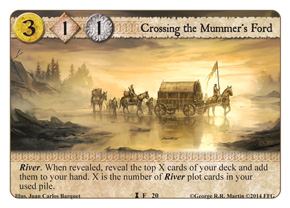
The Mummer’s Ford is situated in the Red Fork, close to the Trident. It is sadly known in the novels for being one of the first locations laid to waste by Ser Gregor’s Band in the start of the War of the Five Kings. Berid Dondarrion and his men were ambushed there; the men that Eddard Stark had sent to capture The Mountain and bring him to justice for his crimes. But the battle, better called the massacre, was brief and it was there, in that Ford, where the Lord of the Bolt died for the first time.
And behind this brief story is hidden one of the most powerful plots of these last times. As almost all rivers, its power does not reside in itself, but in its capacity of making playable (in what a way!) all the rest of the river plots. For the first time it has defined the rivers as a general synergy that can be easily associated by people. If the cities represent the control and kneel, the rivers are a flow of cards, and the Mummer’s Ford is its angular stone.
When revealed, reveal the top X cards of your deck and add them to your hand. X is the number of River plots cards in your used pile.
With this simple text we venture ourselves into a new concept for the rivers, opening a new path: the route of the eleven cards.
This is a sequence of five river plots that allow us to obtain a great advantage of cards in a long term, and that works perfectly with decks with a sparse draw and a big tendency to deflate from turn 3. These decks can be thought in Aggro terms, being good examples of this the classical archetypes of Stark or Greyjoy.
They are also a perfect complement for many KotHH, where in a great way they have displaced the classic plot cycle. In this case there is a great difference between plots that balance really quickly the card difference generated by the malus of the strategy (First Snow, Rule by Decree) and the river plots that give card advantage in a medium and long term.
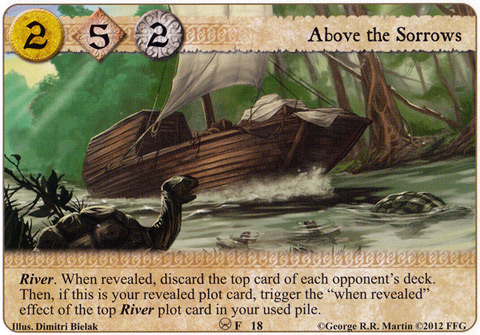
If obtaining a great card advantage, that is the main target of this pack of cards, helps enormously the aggro decks, its collection of small effects results really convenient for the control decks, allowing the recursivity of starting effects (At the Palace of Sorrows) and delaying the opponents game display (Ruby Ford). These effects are also exploited by the aggressive decks, as they allow saving an important character from the rival’s Valar. And, if two cycles ago they weren’t playable given their effects, they have now revealed themselves as the perfect supporting feature to revolve around the concept of card advantage.
How does this route of the eleven cards work?
Actually, it couldn’t be easier. It consists, as we have said, on playing 5 river plots, all of them revolving around the Mummer’s Ford, leaving two free spots available for the plots of each house that could be necessary for the decks strategy, or including a reset. This way we obtain a total number of 11 cards, added to our hand, leaving our draw cap intact. And these are 11 cards that we wouldn’t have obtained by playing a normal plot cycle, or by playing cities.
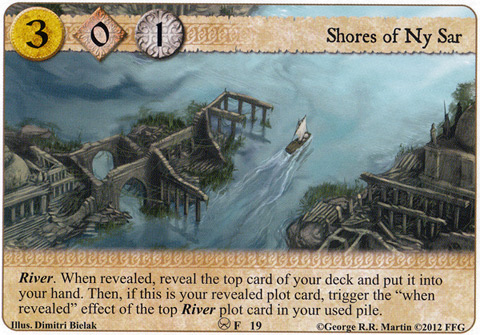
This means that we will have a card advantage of 1 in round 1, 2 in round 2, 4 in round 3, 7 in round 4 and a total of 11 in round 5.
At last the rivers have sense as well as a competitive application, but… isn’t it maybe too competitive? This is one of the big actual polemics. Let’s see a small comparison of what they give and what they take of the game.
Pros:
Incredible draw that is available for all houses and players. It doesn’t depend on luck, you don’t have to draw it and it can support the most diverse strategies, from the most experimental to the most competitive ones. And that’s one of the best parts, as they give competitive power decks with Clansmen, Asshai…etc., that without the rivers wouldn’t be considered more than a tier 2 or 3.
Medium average income, but not strictly low. It is considered that the rivers give very little gold, but if we analyze this route of the eleven cards we see that they sum up a total of 17-18 gold dragons, compared to the 15-16 of the cities. They will possibly need an enforced gold curve, nothing new actually.
They promote long term games, holding up on it if you’re losing or consolidating your domains if you’re winning. Given the fact that they’re usually not played with claim 2, and if they do we’ll find a 2 gold plot, it is a little difficult to materialize that superiority on the table more turns. The long games are usually more interesting and with more game to them.
Cons:
It is easy to consider the rivers as a pack of cards that is too powerful, insisting on them like the obvious choice. They symbolize the “mainstream†of the game right now. Is this a fad or a reality?
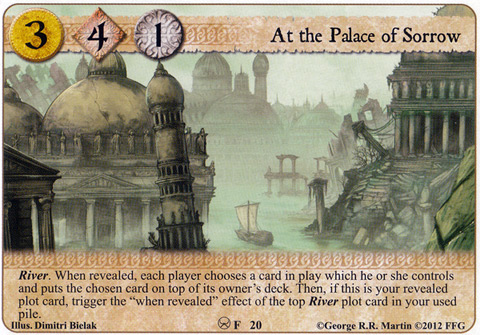
In this they’re similar to what The Long Voyage meant for the game. If this strategy blocked the development of the rest of strategies, this is the same thing that the rivers are doing. It is like if their course would have overflowed, razing with everything like a flood, taking with them other plots and competitive options.
They are the perfect material to think in effects like plot cycling in order to do a real abuse of their mechanic. If cycling cities was devastating, the card flow that the rivers give can break almost any dam of the game. Stark has never had so many cards!
To end we’re going to try to find some solutions against this fluvial hegemony of the plot decks in the current metagame.
The best way to combat the rivers is to deny them their best asset, which is the game on the long term. They start to be truly powerful starting from round 3. So the first countermeasure would be to make the game end before that turn. There are several rush decks that are able to win in three turns, no more, before the rivers start to work at full power. Even if you have to conquer 16 and not 15 power tokens. From Lannister Power Behind the Throne, to a classic Baratheon deck, or some of the new Conquest creations, mixing two houses (usually Martell+Baratheon) where the opening with Art of Seduction in particularly damaging.
A different way of fighting the rivers is by blocking their game. This can be done with different manners, though the one that I find more effective is the one build with the plot cycle that includes First Snow of Winter, Fear of Winter and Rule by Decree. And this is like this because the decks that play with River plots usually include a lot of cheap characters, with cost 2 or less to do a quick deploy even with the 3 gold that give the usual opening plot. A deck that has military power, with a lot of cost three characters that plays these plots can easily destroy completely the river’s strategy, obtaining a great advantage on the table and denying the card advantage that is inherent to them.
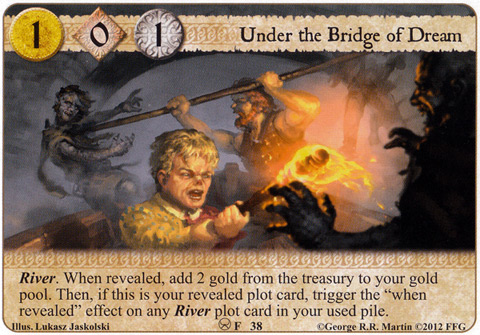
In any case, I am currently of the opinion that it is necessary a balance via FAQs of these plots, that separates them of their main sources of abuse (they are the ones facilitating some of the decks that generate a terrible NPE of the game: Bloodthirst, The Old Ways), vowing for their restriction. And it is that this route of the eleven cards is really worth spending your restricted card on them. Even more if we decided to choose completely the rivers and include Flood Waters in the deck, an event that allows by kneeling 2 influence or a Warship to apply a “when revealed†effect of a River in any used plots pile.
But we can also think, as good Lannisters as we are, on how to get a good profit of this entire situation. In this sense we can thing of reviving a card that is as old as it is forgotten: the Grand Maester Pycelle of the Core Set. Every time that an opponent reveals a card, with his rivers, the good Pycelle will give us a good slice of the cake, adding also cards to our hands. Taking into consideration that against the Shore of Ny Sar and its 0 initiative, we can reveal At the Gates, with initiative 1, to put into play our dear Pycelle, and get some profit of the favorable current from turn 1. It is something to at least take into consideration until the metagame changes.
I hope that you have enjoyed this trip and that this article has helped you to get a little closer to this thrilling world of the rivers of A Song of Ice and Fire, through the path that they suggest in the only game that matters.
And take care when you pass under the Bridge of Dreams!
Thanks for reading and make sure to let me know your thoughts in the comments. If you liked this article make sure to check out some of these other recent articles at rocacasterly.com
- Alex, talism, LorasTyrell and 2 others like this



 Sign In
Sign In Create Account
Create Account











3 Comments
Awesome article Alvaro! I read it on your site and I hope you share more articles like these here on cardgamedb.
Thanks buddy! I will do for sure!
Next week, and article about Tyrion and his different versions across the LCG and the books
Outstanding!
I feel like Tyrion is missing a card that is not only worthy for most decks but is also super nedly(Clansman version is there for goodness and Nedliness, but it's still too niche).
Maaaaaybe a certain World's champion will make a champ card of him.